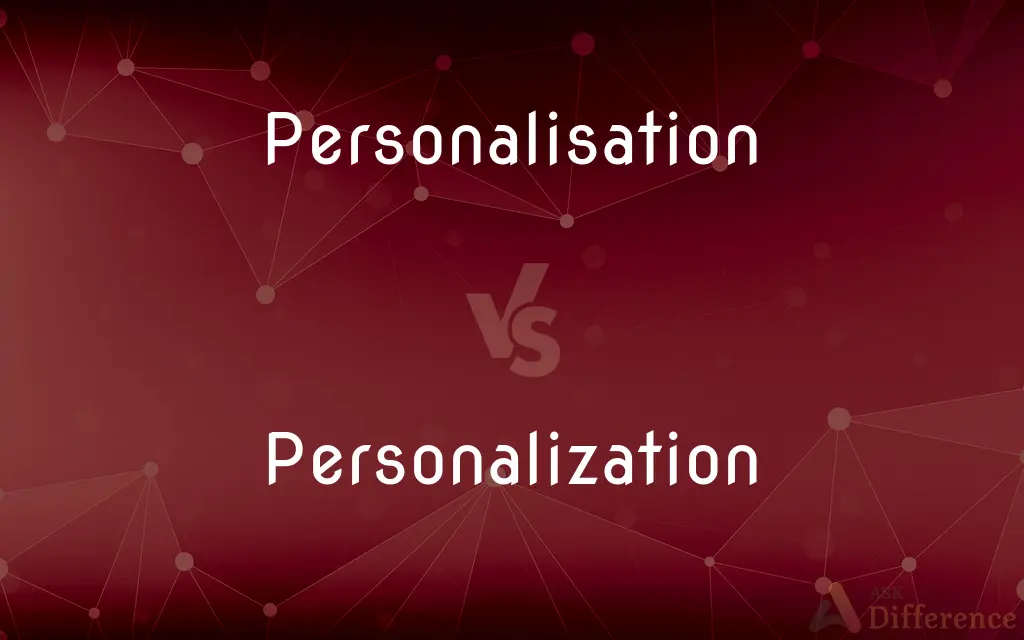Personalisation vs. Personalization — What's the Difference?
By Fiza Rafique & Maham Liaqat — Updated on April 28, 2024
Personalisation and personalization are different spellings of the same concept; the former is used in British English, while the latter in American English.

Difference Between Personalisation and Personalization
Table of Contents
ADVERTISEMENT
Key Differences
Personalisation often appears in British English contexts, reflecting the spelling conventions typical of the UK, such as in "realisation" or "organise". On the other hand, personalization is the preferred spelling in American English, aligning with "realization" and "organize".
In academic and professional writing, personalisation is used by authors and publishers in the UK and Commonwealth countries, emphasizing the adherence to local linguistic norms. Whereas, personalization is predominantly used in the United States, ensuring consistency with American standards of writing and publishing.
In digital marketing, the term personalisation might be seen on UK-based websites, discussing tailored user experiences. Conversely, personalization is frequently used on US-based platforms, highlighting customized content and user interface.
The usage of personalisation in software development can also reflect the location of the development team or target audience, such as in software localisation practices. On the other hand, American software companies tend to use personalization, especially when they address a global market from a US-centric perspective.
In educational content, British educational materials will typically reference personalisation when discussing custom learning experiences. In contrast, American texts will use personalization to describe similar concepts, maintaining consistency with American English usage.
ADVERTISEMENT
Comparison Chart
Language Variant
British English
American English
Common in
UK, Australia, Canada (except Quebec)
United States, Philippines
Examples
Organise, realise, colour
Organize, realize, color
Usage in Academia
Preferred in UK and Commonwealth
Preferred in US institutions
Digital Marketing
Often on UK websites
Predominantly on US websites
Compare with Definitions
Personalisation
The action of designing or producing something to meet someone's individual requirements.
The website offers personalisation of content based on user preferences.
Personalization
The customization of educational experiences to align with the preferences and abilities of students.
Personalization in education can cater to diverse learning styles.
Personalisation
In marketing, tailoring a service or a product to accommodate specific individuals, often using personal data.
Effective personalisation requires careful analysis of customer data.
Personalization
The process of making something suitable for the needs of a particular person.
Personalization tools help increase the relevance of search results.
Personalisation
The process by which a system adjusts its interface or functionality to suit each user.
App personalisation has become essential for enhancing user engagement.
Personalization
Adjusting an environment, such as a user interface, to fit personal preferences and needs.
Smartphone personalization includes changing themes and layouts.
Personalisation
Customization of learning paths in education to suit individual student needs.
Educational personalisation can significantly improve learning outcomes.
Personalization
In digital marketing, the technique of delivering personalized content to users based on their behavior.
Online stores use personalization to recommend products to customers.
Personalisation
Adapting a technology or application to operate under various local conditions, such as languages and customs.
Software personalisation often involves localising content and features.
Personalization
Tailoring software features to fit the cultural and regional preferences of users.
The new app offers personalization features like language selection and theme settings.
Personalisation
(British spelling) personalization
Personalization
Personalization (broadly known as customization) consists of tailoring a service or a product to accommodate specific individuals, sometimes tied to groups or segments of individuals. A wide variety of organizations use personalization to improve customer satisfaction, digital sales conversion, marketing results, branding, and improved website metrics as well as for advertising.
Personalization
To render personal rather than impersonal or purely professional
Personalized the doctor-patient relationship.
Personalization
To make or alter so as to meet individual needs, inclinations, or specifications
Personalize a drug regimen.
Personalize emails to potential customers.
Personalization
To have printed, engraved, or monogrammed with one's name or initials
Personalized the bath towels.
Personalization
To take (a general remark or characterization) in a personal manner.
Personalization
To attribute human or personal qualities to; personify
"songs from the fifties and sixties that personalized automobiles by giving them names" (Christopher Hitchens).
Personalization
The act of personalizing something, or adapting it for somebody's needs or tastes.
Personalization
(computing) The configuration of a software product to suit the needs or tastes of one specific user.
Personalization
(dated) The act of personifying; personification.
Common Curiosities
Is personalisation only relevant in digital contexts?
No, personalisation can also refer to any custom adjustments made in non-digital contexts, such as education and customer services.
How does personalization affect user experience in software applications?
Personalization enhances user experience by adapting the application’s functionality to individual user needs and preferences.
Why does the spelling differ between personalisation and personalization?
The difference in spelling reflects the broader differences between British and American English spelling conventions.
What is the main difference between personalisation and personalization?
The main difference is spelling; personalisation is British English, while personalization is American English.
Does the use of personalisation or personalization affect SEO?
No, both terms are recognized and processed similarly by search engines, but the choice might affect local SEO if regional spelling preferences are significant.
Can personalisation and personalization be used interchangeably?
Yes, they can be used interchangeably depending on the audience's regional English preference.
Which industries most commonly use personalization?
Industries such as digital marketing, e-commerce, education, and software development commonly use personalization.
Is personalization costly to implement in digital platforms?
Implementing personalization can be initially costly but often results in higher user engagement and ROI.
How do companies collect data for personalization purposes?
Companies collect data through user interactions, cookies, and tracking tools to understand behavior and preferences.
What is a common feature of personalization in online shopping?
A common feature is the use of algorithms to suggest products based on past purchases and browsing behavior.
What are the benefits of personalisation in education?
Personalisation in education helps cater to individual learning styles, potentially increasing engagement and effectiveness.
What role does personalisation play in mobile app development?
Personalisation is crucial in app development for creating user-friendly interfaces that adapt to individual preferences.
What ethical considerations are associated with personalisation?
Ethical considerations include privacy concerns and the responsible use of personal data.
How does personalisation impact customer loyalty?
By making customers feel valued and understood, personalisation can significantly boost customer loyalty.
Can personalisation improve accessibility in digital products?
Yes, personalisation can improve accessibility by allowing users to adjust settings to meet their specific accessibility needs.
Share Your Discovery

Previous Comparison
Inhabitable vs. Uninhabitable
Next Comparison
Tights vs. StockingsAuthor Spotlight
Written by
Fiza RafiqueFiza Rafique is a skilled content writer at AskDifference.com, where she meticulously refines and enhances written pieces. Drawing from her vast editorial expertise, Fiza ensures clarity, accuracy, and precision in every article. Passionate about language, she continually seeks to elevate the quality of content for readers worldwide.
Co-written by
Maham Liaqat















































